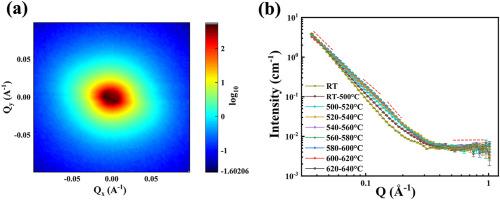基于SANS表征的铝钛原位反应过程中复合材料的微观结构演变
IF 7.7
2区 材料科学
Q1 MATERIALS SCIENCE, COMPOSITES
引用次数: 0
摘要
铝基复合材料(AMCs)的高温性能是其在极端环境下应用的关键。利用Al与氧化钛的原位反应,采用溶胶-凝胶和粉末冶金法制备了一种耐热(Al2O3+Al3Ti)/Al复合材料。虽然以前的工作证明了其优异的热稳定性,但由于传统表征技术的限制,反应过程仍然知之甚少。本文采用小角中子散射(SANS)、扫描电子显微镜(SEM)和透射电子显微镜(TEM)相结合的综合多尺度方法来揭示反应动力学。SANS分析定量地揭示了反应的起始温度(580℃)和结束温度(620℃),TEM和SEM鉴定了Al2O3和Al3Ti相的顺序形成。该方法克服了传统方法的统计局限性,将宏观尺度的散射数据与原子尺度的微观结构演变联系起来。该研究结果为实时监测纳米级反应和AMCs的微观结构优化建立了一个通用框架,为通过可控原位合成设计高性能复合材料提供了重要见解。本文章由计算机程序翻译,如有差异,请以英文原文为准。

Microstructure evolution of composite during in-situ reaction of aluminum and titanium oxide based on SANS characterization
The high-temperature performance of aluminum matrix composites (AMCs) is pivotal for their applications in extreme environments. This study focuses on a heat-resistant (Al2O3+Al3Ti)/Al composite synthesized via sol-gel and powder metallurgy, leveraging the in-situ reaction between Al and titanium oxide. While previous work demonstrated its exceptional thermal stability, the reaction process remained poorly understood due to limitations in conventional characterization techniques. Here, an integrated multi-scale approach combining small-angle neutron scattering (SANS), scanning electron microscopy (SEM), and transmission electron microscopy (TEM) was employed to unravel the reaction dynamics. SANS analysis quantitatively revealed the reaction initiation (580 °C) and completion (620 °C) temperatures, while TEM and SEM identified the sequential formation of Al2O3 and Al3Ti phases. This methodology bridges macro-scale scattering data with atomic-scale microstructural evolution, overcoming statistical limitations of traditional techniques. The findings establish a universal framework for real-time monitoring of nanoscale reactions and microstructure optimization in AMCs, offering critical insights for designing high-performance composites through controlled in-situ synthesis.
求助全文
通过发布文献求助,成功后即可免费获取论文全文。
去求助
来源期刊

Composites Communications
Materials Science-Ceramics and Composites
CiteScore
12.10
自引率
10.00%
发文量
340
审稿时长
36 days
期刊介绍:
Composites Communications (Compos. Commun.) is a peer-reviewed journal publishing short communications and letters on the latest advances in composites science and technology. With a rapid review and publication process, its goal is to disseminate new knowledge promptly within the composites community. The journal welcomes manuscripts presenting creative concepts and new findings in design, state-of-the-art approaches in processing, synthesis, characterization, and mechanics modeling. In addition to traditional fiber-/particulate-reinforced engineering composites, it encourages submissions on composites with exceptional physical, mechanical, and fracture properties, as well as those with unique functions and significant application potential. This includes biomimetic and bio-inspired composites for biomedical applications, functional nano-composites for thermal management and energy applications, and composites designed for extreme service environments.
 求助内容:
求助内容: 应助结果提醒方式:
应助结果提醒方式:


